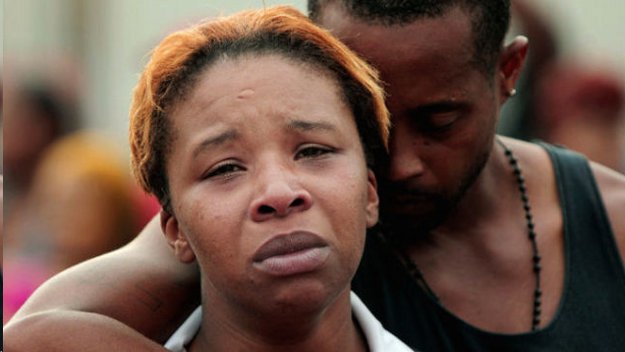The Second Slaying of Michael Brown

From our content partner New America Media:
The instant the news broke that 18-year old Michael Brown was slain by a Ferguson, Missouri cop the inevitable happened. Police officials dusted off a well-worn cover themselves template. They would either hold a press conference, publicly release, or leak documents that depicted Brown as having gang ties, smoked dope, dealt dope, had an arrest record, was a school trouble maker, or engaged in some kind of deviant behavior. With Brown, they added to their cover themselves template by waving pictures to the national press that purported to show Brown robbing a convenience store moments before he was gunned down.
The crude and clumsy message was that Brown was a bad guy. Though they didn’t dare say it openly, the even more unstated but lethal message was that there was a legitimate cause, if not outright justification, for the deadly train of events that occurred. The aim of the savage assault on Brown's character was to deconstruct him as an innocent victim. If enough dirt could be tossed at Brown to cast doubt and suspicion about his character and motives, then maybe there was probable cause to kill.
Brown’s parents swiftly and correctly denounced this brazen and clumsy effort to bestow absolution on the cop that killed him as character assassination of the vilest order. Police produced not a shred of hard evidence at the moment they pointed the criminal blame finger at him to nail him as the culprit. But even if he was a legitimate suspect in the theft, he was not stopped, confronted and shot because of that. He was stopped for allegedly jay walking. There was no other offense at that moment than that. A suspected robbery hours before can’t absolve or cancel out the hard fact that Brown was unarmed, and as stated by multiple eyewitnesses was compliant with the officer. The only reason the officer was not arrested and charged with murder is precisely because he is an officer.
The problem though with the silliness of this juvenile attempt by police officials to cover themselves is that they hold most of the cards in these cases. They know that merely dropping a tell-tell litany of veiled and not so veiled hints, innuendoes, digs, and crass, snide, accusing comments, remarks, slander and outright lies about men like Brown is more than enough to divert, distract, and pollute the air surrounding the killing. The image mugging often works because it rests firmly on the ancient, shop worn, but serviceable litany of stereotypes and negative typecasting of young black males. It’s the shortest of short steps to think that if Brown can be depicted as a caricature of the terrifying image that much of the public still harbors about young black males, then that image seems real, even more terrifying, and the consequences are just as deadly.
The hope was that President Obama’s election buried once and for all negative racial typecasting and the perennial threat racial stereotypes posed to the safety and well-being of black males. It did no such thing. Immediately after Obama’s election teams of researchers from several major universities found that many of the old stereotypes about poverty and crime and blacks remained just as frozen in time. The study found that much of the public still perceived those most likely to commit crimes are poor, jobless and black. The study did more than affirm that race and poverty and crime were firmly rammed together in the public mind. It also showed that once the stereotype is planted, it’s virtually impossible to root out. That’s hardly new either.

In 2003 and 2008 Penn State University researchers found that many whites are likely to associate pictures of blacks with violent crime. This was no surprise given the relentless media depictions of young blacks as dysfunctional, dope peddling, gang bangers and drive-by shooters. The Penn State study found that even when blacks didn’t commit a specific crime, whites still misidentified the perpetrator as an African-American. Immediately after the election of Obama, the researchers still found public attitudes on crime and race unchanged. The majority of whites still overwhelmingly fingered blacks as the most likely to commit crimes, even when they didn’t commit them.
The gunning down of unarmed young blacks is not the only lethal consequence of this warped public perception of black males. A Stanford study released days before Brown's killing found that a significant number of whites and non-whites were even more willing to cheer tough sentencing, three strikes laws, and draconian drug busts, when they perceive that the majority of those busted and imprisoned are black. Though no study has yet been done on it, it wouldn’t surprise, in the backdrop of the disturbances in Ferguson following Brown’s slaying that a significant number of Americans would applaud the use of the massive war zone weaponry and tactics against American citizens that was used in Ferguson, as long as those citizens were perceived as young blacks.
The image mugging of Brown doesn’t change the official record. He was killed not because he was a suspected robber, but a suspected jaywalker. To suggest anything else is nothing more than a second slaying of Brown.
Author Bio:
Earl Ofari Hutchinson is an author and political analyst. He is a frequent political commentator on MSNBC and a weekly co-host of the Al Sharpton Show on American Urban Radio Network. He is the author of How Obama Governed: The Year of Crisis and Challenge. He is an associate editor of New America Media. He is the host of the weekly Hutchinson Report on KPFK-Radio and the Pacifica Network.
From our content partner New America Media




























































































































































































































































































































